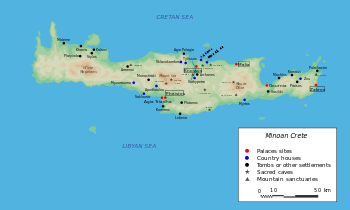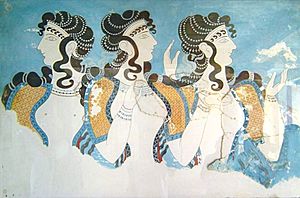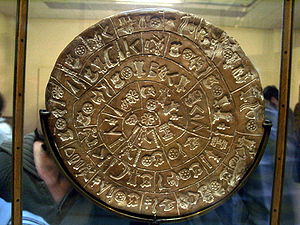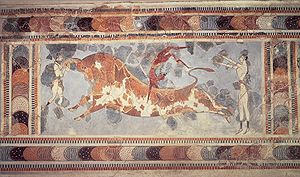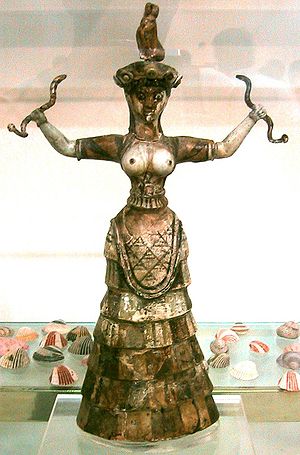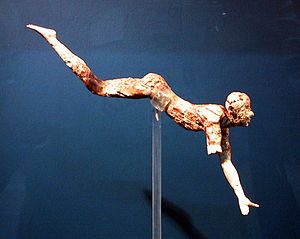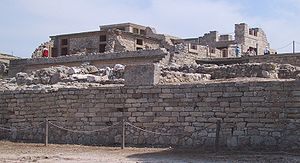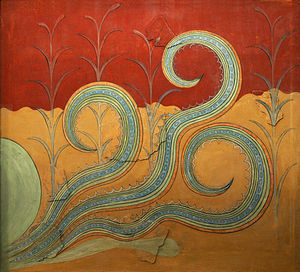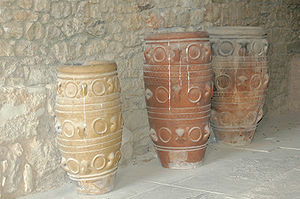
Minoan civilization
Background to the schools Wikipedia
SOS Children made this Wikipedia selection alongside other schools resources. To compare sponsorship charities this is the best sponsorship link.
| Bronze Age |
|---|
| ↑ Chalcolithic |
|
Near East (3600-1200 BC)
Europe (3750-600 BC)
Indian Subcontinent (3300-1200 BC) China (3000-700 BC) Korea (800-300 BC) |
|
arsenical bronze |
| ↓ Iron Age |
The Minoan civilization was a Bronze Age civilization that arose on the island of Crete and flourished from approximately the 27th century BCE to the 15th century BCE. It was rediscovered at the beginning of the 20th century through the work of the British archaeologist Arthur Evans. Will Durant referred to it as "the first link in the European chain." The early inhabitants of Crete settled as early as 128,000 BCE, during the Middle Paleolithic age. However it was not until 5000 BCE that the first signs of advanced agriculture appeared, marking the beginning of the civilization.
Overview
The term "Minoan" was coined by Arthur Evans after the mythic "king" Minos. Minos was associated in Greek myth with the labyrinth, which Evans identified with the site at Knossos. It has sometimes been argued that the Egyptian place name "Keftiu" (*Káftiu kftiw) and the Semitic "Kaftor" or " Caphtor" and "Kaptara" in the Mari archives refer to the island of Crete; "On the other hand some acknowledged facts about Caphtor/Keftiu can only with difficulty be reconciled with Crete," observes John Strange. In the Odyssey, composed centuries after the destruction of the Minoan civilization, Homer calls the natives of Crete Eteocretans ("true Cretans"); these may have been descendants of the Minoans.
Minoan palaces (anaktora) are the best known building types to have been excavated on the island. They are monumental buildings serving administrative purposes as evidenced by the large archives unearthed by archaeologists. Each of the palaces excavated to date has its own unique features, but they alo share features which set them apart from other structures. The palaces were often multi-storied, with interior and exterior staircases, light wells, massive columns, storage magazines and courtyards.
It seems that the Minoan people were not Indo-European, and that they were even related to the pre-Greek dwellers of the Greek mainland and Western Anatolia, the so-called Pelasgians.
Chronology and history
Rather than associate absolute calendar dates for the Minoan period, archaeologists use two systems of relative chronology. The first, created by Evans and modified by later archaeologists, is based on pottery styles. It divides the Minoan period into three main eras—Early Minoan (EM), Middle Minoan (MM), and Late Minoan (LM). These eras are further subdivided, e.g. Early Minoan I, II, III (EMI, EMII, EMIII). Another dating system, proposed by the Greek archaeologist Nicolas Platon, is based on the development of the architectural complexes known as "palaces" at Knossos, Phaistos, Malia, and Kato Zakros, and divides the Minoan period into Prepalatial, Protopalatial, Neopalatial, and Post-palatial periods. The relationship among these systems is given in the accompanying table, with approximate calendar dates drawn from Warren and Hankey (1989).
The Thera eruption occurred during a mature phase of the LM IA period. The calendar date of the volcanic eruption is extremely controversial. Radiocarbon dating has indicated a date in the late 17th century BCE; those radiocarbon dates, however, conflict with the estimates of archaeologists who synchronize the eruption with the Conventional Egyptian chronology and obtain a date of around 1525-1500 BCE. See the article on dating the Thera eruption for more discussion. The eruption often is identified as a natural event catastrophic for the culture, leading to its rapid collapse.
History
| Minoan chronology | |||||||||||||
|---|---|---|---|---|---|---|---|---|---|---|---|---|---|
| 3650-3000 BCE | EMI | Prepalatial | |||||||||||
| 2900-2300 BCE | EMII | ||||||||||||
| 2300-2160 BCE | EMIII | ||||||||||||
| 2160-1900 BCE | MMIA | ||||||||||||
| 1900-1800 BCE | MMIB | Protopalatial (Old Palace Period) |
|||||||||||
| 1800-1700 BCE | MMII | ||||||||||||
| 1700-1640 BCE | MMIIIA | Neopalatial (New Palace Period) |
|||||||||||
| 1640-1600 BCE | MMIIIB | ||||||||||||
| 1600-1480 BCE | LMIA | ||||||||||||
| 1480-1425 BCE | LMIB | ||||||||||||
| 1425-1390 BCE | LMII | Postpalatial (At Knossos, Final Palace Period) |
|||||||||||
| 1390-1370 BCE | LMIIIA1 | ||||||||||||
| 1370-1340 BCE | LMIIIA2 | ||||||||||||
| 1340-1190 BCE | LMIIIB | ||||||||||||
| 1190-1170 BCE | LMIIIC | ||||||||||||
| 1100 BCE | Subminoan | ||||||||||||
The oldest evidence of inhabitants on Crete are preceramic Neolithic farming community remains that date to approximately 7000 BCE. A comparative study of DNA haplogroups of modern Cretan men showed that a male founder group from Anatolia or the Levant, is shared with the Greeks. The neolithic population dwelt in open villages. On the shores, there were fishermen's huts, while the fertile Mesara Plain was used for agriculture.
The Bronze Age began in Crete around 2700 BCE. In the late 3rd Millenium BCE, several localities on the island developed into centers of commerce and handwork. This enabled the upper classes to continuously practice leadership activities and to expand their influence. It is likely that the original hierarchies of the local elites were replaced by monarchist power structures - a precondition for the creation of the great palaces. From the Early Bronze Age (3500 BCE to 2600 BCE), the Minoan civilization on Crete showed a promise of greatness.
At the end of the MMII period (1700 BCE) there was a large disturbance in Crete, probably an earthquake, or possibly an invasion from Anatolia. The palaces at Knossos, Phaistos, Malia, and Kato Zakros were destroyed. But with the start of the Neopalatial period, population increased again, the palaces were rebuilt on a larger scale and new settlements were built all over the island. This period (the 17th and 16th centuries BCE, MM III / Neopalatial) represents the apex of the Minoan civilization. There was another natural catastrophe around 1600 BCE, possibly an eruption of the Thera volcano. Even this disaster didn't discourage the Minoans: the palaces were again rebuilt and were made even greater than before.
The influence of the Minoan civilization outside Crete manifests itself in the presence of valuable Minoan handicraft items on the Greek mainland. It is likely that the ruling house of Mycene was connected to the Minoan trade network. After around 1700 BCE, the material culture on the Greek mainland achieved a new level due to Minoan influence. Connections between Egypt and Crete are prominent. Minoan ceramics are found in Egyptian cities and the Minoans imported several items from Egypt, especially papyrus, as well as architectural and artistic ideas. The Egyptian hieroglyphs served as a model for the Minoan pictographic writing, from which the famous Linear A and Linear B writing systems later developed.
Around 1450 BCE, Minoan culture experienced a turning point due to a natural catastrophe, possibly an earthquake. Another eruption of the Thera volcano has been linked to this downfall, but its dating and implications remain controversial. Several important palaces in locations such as Mallia, Tylissos, Phaistos, Hagia Triade as well as the living quarters of Knossos were destroyed. The palace in Knossos seems to have remained largely intact. This resulted in the Dynasty in Knossos being able to spread its influence over large parts of Crete, until it was overrun by Mycenaean Greeks.
The Minoan palace sites were occupied by the Myceneans around 1420 BCE (1375 BCE according to other sources), who adapted the Linear A Minoan script to the needs of their own Mycenaean language, a form of Greek, which was written in Linear B. The first such archive anywhere is in the LMII-era "Room of the Chariot Tablets". The Myceneans generally tended to adapt, rather than destroy, Minoan culture, religion and art, and they continued to operate the economic system and bureaucracy of the Minoans.
During LMIIIA:1, Amenhotep III at Kom el-Hatan took note of k-f-t-w (Kaftor) as one of the "Secret Lands of the North of Asia". Also mentioned are Cretan cities such as Ἀμνισός (Amnisos), Φαιστός (Phaistos), Κυδωνία (Kydonia) and Kνωσσός (Knossos) and some toponyms reconstructed as belonging to the Cyclades or the Greek mainland. If the values of these Egyptian names are accurate, then this Pharaoh did not privilege LMIII Knossos above the other states in the region.
After about a century of partial recovery, most Cretan cities and palaces went into decline in the 13th century BCE (LHIIIB/LMIIIB). The last Linear A archives date to LMIIIA (contemporary with LHIIIA).
Knossos remained an administrative centre until 1200 BCE; the last of the Minoan sites was the defensive mountain site of Karfi, a refuge site which displays vestiges of Minoan civilization almost into the Iron Age.
Geography
Crete is a mountainous island with natural harbours. There are signs of earthquake damage at many Minoan sites and clear signs of both uplifting of land and submersion of coastal sites due to tectonic processes all along the coasts.
Homer recorded a tradition that Crete had 90 cities. To judge from the palace sites the island was probably divided into at least eight political units during the height of the Minoan period. The north is thought to have been governed from Knossos, the south from Phaistos, the central eastern part from Malia, and the eastern tip from Kato Zakros and the west from Chania. Smaller palaces have been found in other places.
Some of the major Minoan archaeological sites are:
- Palaces
- Knossos - the largest Bronze Age archaeological site on Crete; was purchased for excavations by Evans on March 16, 1900.
- Phaistos - the second largest palatial building on the island, excavated by the Italian school shortly after Knossos
- Malia - the subject of French excavations, a palatial centre which affords a look into the development of the palaces in the protopalatial period
- Kato Zakros - a palatial site excavated by Greek archaeologists in the far east of the island. This is also referred to as "Zakro" in archaeological literature.
- Galatas - the most recently confirmed palatial site
- Agia Triada - an administrative centre close to Phaistos
- Gournia - a town site excavated in the first quarter of the 20th century by the American School
- Pyrgos - an early Minoan site on the south of the island
- Vasiliki - an early Minoan site towards the east of the island which gives its name to a distinctive ceramic ware
- Fournu Korfi - a site on the south of the island
- Pseira - island town with ritual sites
- Mount Juktas - the greatest of the Minoan peak sanctuaries because of its association with the palace of Knossos
- Arkalochori - the find site of the famous Arkalochori Axe
- Karfi - a refuge site from the late Minoan period, one of the last of the Minoan sites
- Akrotiri - settlement on the island of Santorini (Thera), near the site of the Thera Eruption
- Zominthos - a mountainous city in the northern foothills of Mount Ida
Minoans beyond Crete
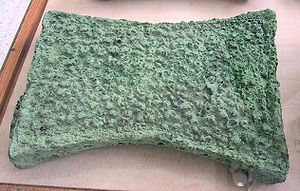
Minoans were traders, and their cultural contacts reached far beyond the island of Crete — to Egypt's Old Kingdom, to copper-bearing Cyprus, Canaan, and the Levantine coasts beyond, and to Anatolia. In late 2009, Minoan-style frescoes and other Minoan-style artifacts were discovered during excavations of the Canaanite palace at Tel Kabri, Israel, leading archaeologists to conclude that the Minoan influence was the strongest foreign influence on that Caananite city state. These are the only Minoan remains ever found in Israel.
Minoan techniques and styles in ceramics also provided models, of fluctuating influence, for Helladic Greece. Along with the familiar example of Thera, Minoan "colonies" can be found first at Kastri on Cythera, an island close to the Greek mainland that came under Minoan influence in the mid-third millennium (EMII) and remained Minoan in culture for a thousand years, until Mycenaean occupation in the 13th century. The use of the term "colony", however, like "thalassocracy", has been criticized in recent years. The Minoan strata there replace a mainland-derived culture in the Early Bronze Age, the earliest Minoan settlement outside Crete. The Cyclades were in the Minoan cultural orbit, and, closer to Crete, the islands of Karpathos, Saros and Kasos, also contained Minoan colonies, or settlements of Minoan traders, from the Middle Bronze Age (MMI-II); most of them were abandoned in LMI, but Minoan Karpathos recovered and continued with a Minoan culture until the end of the Bronze Age. Other supposed Minoan colonies, such as that hypothesised by Adolf Furtwängler for Aegina, were later dismissed. There was a Minoan colony at Ialysos on Rhodes.
Minoan cultural influence indicates an orbit that extended not only throughout the Cyclades (so-called Minoanisation), but in locations such as Egypt and Cyprus. Paintings from the 15th century BCE, in Thebes, Egypt depict a number of individuals that are Minoan in appearance bearing gifts. Inscriptions record these people as coming from Keftiu, or the "islands in the midst of the sea", and may refer to gift-bringing merchants or officials from Crete.
Certain locations within Crete emphasize it as an "outward looking" society. The Neopalatial site of Kato Zakros, for instance, is located within 100 metres of the modern shore-line, situated within a bay. Its large number of workshops and the richness of its site materials indicate a potential 'entrepôt' for import and export. Such activities are elaborated in artistic representations of the sea, including the 'Flotilla' fresco from room 5, in the west house at Akrotiri.
Society and culture
The Minoans were primarily a mercantile people engaged in overseas trade. Their culture, from 1700 BCE onward, shows a high degree of organization.
Many historians and archaeologists believe that the Minoans were involved in the Bronze Age's important tin trade: tin, alloyed with copper apparently from Cyprus, was used to make bronze. The decline of Minoan civilization and the decline in use of bronze tools in favour of iron ones seem to be correlated.
The Minoan trade in saffron, the stigma of a mutated crocus which originated in the Aegean basin as a natural chromosome mutation, has left fewer material remains: a fresco of saffron-gatherers at Santorini is well-known. This inherited trade pre-dated Minoan civilization: a sense of its rewards may be gained by comparing its value to frankincense, or later, to pepper. Archaeologists tend to emphasize the more durable items of trade: ceramics, copper, and tin, and dramatic luxury finds of gold and silver.
Objects of Minoan manufacture suggest there was a network of trade with mainland Greece (notably Mycenae), Cyprus, Syria, Anatolia, Egypt, Mesopotamia, and westward as far as the coast of Spain.
Minoan men wore loincloths and kilts. Women wore robes that had short sleeves and layered flounced skirts. These were open to the navel allowing their breasts to be left exposed, perhaps during ceremonial occasions. Women also had the option of wearing a strapless fitted bodice. The patterns on clothes emphasized symmetrical geometric designs. It must be remembered that other forms of dress may have been worn of which we have no record.
The Minoan religion focused on female deities, with females officiating. The statues of priestesses in Minoan culture and frescoes showing men and women participating in the same sports such as bull-leaping, lead some archaeologists to believe that men and women held equal social status. Inheritance is thought to have been matrilineal. The frescos include many depictions of people, with the genders distinguished by colour: the men's skin is reddish-brown, the women's white.
Concentration of wealth played a large role in the structure of society. Multiroom constructions were discovered in even the ‘poor’ areas of town, revealing a social equality and even distribution of wealth.
Language and writing
Knowledge of the spoken and written language of the Minoans is scant, due to the small number of records found. Around 3000 BCE clay tablets were found with the various Cretan scripts. Clay tablets seem to have been in use from around 3000 BCE or earlier. Two clay cups from Knossos have been found to have remnants of ink, and inkwells similar to the animal-shaped inkstands from Mesopotamia have also been found.
Sometimes the Minoan language is referred to as Eteocretan, but this presents confusion between the language written in Linear A scripts and the language written in a Euboean-derived alphabet after the Greek Dark Ages. While the Eteocretan language is believed to be a descendant of Minoan, there is not enough source material in either language to allow conclusions to be made.
The earliest dated writing found on Crete is the Cretan hieroglyphs. It is not known if this language is Minoan and scholars often debate as to where it originated. These hieroglyphs are often associated with the Egyptians but also show relation to several other writings from the region of Mesopotamia. The hieroglyphs came into use from MMI and were in parallel use with the emerging Linear A from the 18th century BCE (MM II) and disappeared at some point during the 17th century BCE (MM III).
In the Mycenean period, Linear A was replaced by Linear B, recording a very archaic version of the Greek language. Linear B was successfully deciphered by Michael Ventris in 1952, but the earlier scripts remain a mystery. The overwhelming majority of tablets are written in the Linear B script, apparently being inventories of goods or resources. Others are inscriptions on religious objects associated with a cult. Because most of these inscriptions are concise economic records rather than dedicatory inscriptions, the translation of Minoan remains a challenge.
Unless Eteocretan truly is its descendant, it is perhaps during the Greek Dark Ages, a time of economic and socio-political collapse, that the Minoan language became extinct.
Art
The collection of Minoan art is in the museum at Heraklion, near Knossos on the north shore of Crete. Minoan art, with other remains of material culture, especially the sequence of ceramic styles, has allowed archaeologists to define the three phases of Minoan culture (EM, MM, LM) discussed above.
Since wood and textiles have vanished through decomposition, the best preserved, and so most easily learned from, surviving examples of Minoan art are Minoan pottery, the palace architecture with its frescos that include landscapes, stone carvings, and intricately carved seal stones.
Pottery
In the Early Minoan period ceramics were characterised by linear patterns of spirals, triangles, curved lines, crosses, fishbone motifs, and such. In the Middle Minoan period naturalistic designs such as fish, squid, birds, and lilies were common. In the Late Minoan period, flowers and animals were still the most characteristic, but the variability had increased. The 'palace style' of the region around Knossos is characterised by a strong geometric simplification of naturalistic shapes and monochromatic paintings. Very noteworthy are the similarities between Late Minoan and Mycenaean art. Frescoes were the main form of art during these time of the Minoan culture.
Religion
The Minoans seem to have worshipped primarily goddesses, which has sometimes been described as a " matriarchal religion". Although there is some evidence of male gods, depictions of Minoan goddesses vastly outnumber depictions of anything that could be considered a Minoan god. While some of these depictions of women are speculated to be images of worshippers and priestesses officiating at religious ceremonies, as opposed to the deity herself, there still seem to be several goddesses including a Mother Goddess of fertility, a Mistress of the Animals, a protectress of cities, the household, the harvest, and the underworld, and more. Some have argued that these are all aspects of a single Great Goddess. They are often represented by serpents, birds, poppies, and a somewhat vague shape of an animal upon the head.
A major festive celebration was exemplified in the famous athletic Minoan bull dance, represented at large in the frescoes of Knossos and inscribed in miniature seals.
The Minoan horn-topped altars, since Evans' time conventionally called " Horns of Consecration" are represented in seal impressions, and survive in examples as far afield as Cyprus.
Minoan sacred symbols include the bull and its horns of consecration, the labrys (double-headed axe), the pillar, the serpent, the sun-disk, and the tree. However, recently a completely different interpretation of these symbols, focusing on apiculture instead of religious significance, has been suggested.
Evidence that suggests the Minoans may have performed human sacrifice has been found at three sites: (1) Anemospilia, in a MMII building near Mt. Juktas, interpreted as a temple, (2) an EMII sanctuary complex at Fournou Korifi in south central Crete, and (3) Knossos, in an LMIB building known as the "North House." (explanation of abbreviations)
Like much of the archaeology of the Bronze Age, burial remains constitute much of the material and archaeological evidence for the period. By the end of the Second Palace Period Minoan burial practice is dominated by two broad forms: 'Circular Tombs', or Tholoi, (located in South Crete) and 'House Tombs', (located in the north and the east). Of course, there are many trends and patterns within Minoan mortuary practice that do not conform to this simple breakdown. Over all, inhumation was the most popular form of burial, cremation does not seem to have been a popular means of burial in Bronze Age Crete. Throughout this period there is a trend towards individual burials, with some distinguished exceptions. These include the much-debated Chrysolakkos complex, Mallia, consisting of a number of buildings forming a complex. This is located in the centre of Mallia's burial area and may have been the focus for burial rituals, or the 'crypt' for a notable family.
Warfare and "The Minoan Peace"
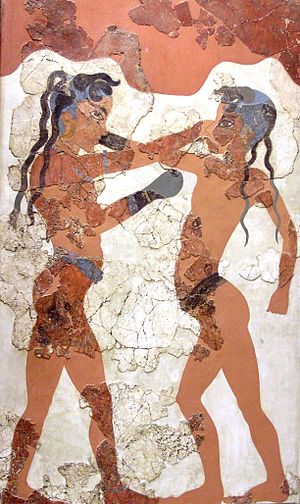
Though the vision created by Arthur Evans of a pax Minoica, a "Minoan peace", has been criticised in recent years, it is generally assumed there was little internal armed conflict in Minoan Crete itself, until the following Mycenaean period. As with much of Minoan Crete, however, it is hard to draw any obvious conclusions from the evidence. However, new excavations keep sustaining interest and documenting the impact around the Aegean.
Despite having found ruined watchtowers and fortification walls, Evans argued that there was little evidence for ancient Minoan fortifications. But as S. Alexiou has pointed out (in Kretologia 8), a number of sites, especially Early and Middle Minoan sites such as Aghia Photia, are built on hilltops or are otherwise fortified. As Lucia Nixon said, "...we may have been over-influenced by the lack of what we might think of as solid fortifications to assess the archaeological evidence properly. As in so many other instances, we may not have been looking for evidence in the right places, and therefore we may not end with a correct assessment of the Minoans and their ability to avoid war.".
Chester Starr points out in "Minoan Flower Lovers" (Hagg-Marinatos eds. Minoan Thalassocracy) that Shang China and the Maya both had unfortified centers and yet still engaged in frontier struggles, so that itself cannot be enough to definitively show the Minoans were a peaceful civilization unparalleled in history.
In 1998, however, when Minoan archaeologists met in a conference in Belgium to discuss the possibility that the idea of Pax Minoica was outdated, the evidence for Minoan war proved to be scanty.
Archaeologist Jan Driessen, for example, said the Minoans frequently show 'weapons' in their art, but only in ritual contexts, and that "The construction of fortified sites is often assumed to reflect a threat of warfare, but such fortified centres were multifunctional; they were also often the embodiment or material expression of the central places of the territories at the same time as being monuments glorifying and merging leading power" (Driessen 1999, p. 16).
On the other hand, Stella Chryssoulaki's work on the small outposts or 'guard-houses' in the east of the island represent possible elements of a defensive system. Claims that they produced no weapons are erroneous; type A Minoan swords (as found in palaces of Mallia and Zarkos) were the finest in all of the Aegean (See Sanders, AJA 65, 67, Hoeckmann, JRGZM 27, or Rehak and Younger, AJA 102).
Keith Branigan claimed that 95% of so-called Minoan weapons possessed hafting (hilts, handles) that would have prevented their use as weapons (Branigan, 1999); more recent experimental testing of accurate replicas has shown this to be incorrect as these weapons were capable of cutting flesh down to the bone (and scoring the bone's surface) without any damage to the weapons themselves. Archaeologist Paul Rehak maintains that Minoan figure-eight shields could not have been used for fighting or even hunting, since they were too cumbersome (Rehak, 1999). And archaeologist Jan Driessen says the Minoans frequently show 'weapons' in their art, but only in ritual contexts (Driessen 1999). Finally, archaeologist Cheryl Floyd concludes that Minoan "weapons" were merely tools used for mundane tasks such as meat-processing (Floyd, 1999). However, this theory is thrown into question by evidence of "rapiers nearly three feet in length" dated to the Middle Minoan period.
About Minoan warfare, Branigan concludes that "The quantity of weaponry, the impressive fortifications, and the aggressive looking long-boats all suggested an era of intensified hostilities. But on closer inspection there are grounds for thinking that all three key elements are bound up as much with status statements, display, and fashion as with aggression.... Warfare such as there was in the southern Aegean EBA early Bronze Age was either personalized and perhaps ritualized (in Crete) or small-scale, intermittent and essentially an economic activity (in the Cyclades and the Argolid/Attica) " (1999, p. 92). Archaeologist Krzyszkowska concurs: "The stark fact is that for the prehistoric Aegean we have no direct evidence for war and warfare per se" (Krzyszkowska, 1999).
Furthermore, no evidence exists for a Minoan army, or for Minoan domination of peoples outside Crete. Few signs of warfare appear in Minoan art. "Although a few archaeologists see war scenes in a few pieces of Minoan art, others interpret even these scenes as festivals, sacred dance, or sports events" (Studebaker, 2004, p. 27). Although armed warriors are depicted being stabbed in the throat with swords, violence may occur in the context of ritual or blood sport.
Although on the Mainland of Greece at the time of the Shaft Graves at Mycenae, there is little evidence for major fortifications among the Mycenaeans there (the famous citadels post-date the destruction of almost all Neopalatial Cretan sites), the constant warmongering of other contemporaries of the ancient Minoans – the Egyptians and Hittites, for example – is well documented.
Architecture
The Minoan cities were connected with stone-paved roads, formed from blocks cut with bronze saws. Streets were drained and water and sewer facilities were available to the upper class, through clay pipes.
Minoan buildings often had flat tiled roofs; plaster, wood, or flagstone floors, and stood two to three storeys high. Typically the lower walls were constructed of stone and rubble, and the upper walls of mudbrick. Ceiling timbers held up the roofs.
The materials used in constructing the villas and palaces varied, and could include sandstone, gypsum, or limestone. Equally, building techniques could also vary between different constructions; some palaces used ashlar masonry while others used roughly hewn megalithic blocks.
Palaces
The first palaces were constructed at the end of the Early Minoan period in the third millennium BCE ( Malia). While it was formerly believed that the foundation of the first palaces was synchronous and dated to the Middle Minoan at around 2000 BCE (the date of the first palace at Knossos), scholars now think that palaces were built over a longer period in different locations, in response to local developments. The main older palaces are Knossos, Malia, and Phaistos. Some of the elements recorded in the Middle Minoan 'palaces' (Knossos, Phaistos and Mallia, for example) have precedents in earlier styles of construction in the Early Minoan period. These include the indented western court, and the special treatment given to the western façade. An example of this is seen at the "House on the Hill" at Vasiliki, dated to the Early Minoan II period.
The palaces fulfilled a plethora of functions: they served as centres of government, administrative offices, shrines, workshops, and storage spaces (e.g., for grain). These distinctions might have seemed artificial to Minoans.
The use of the term 'palace' for the older palaces, meaning a dynastic residence and seat of power, has recently come under criticism (see Palace), and the term 'court building' has been proposed instead. However, the original term is probably too well entrenched to be replaced. Architectural features such as ashlar masonry, orthostats, columns, open courts, staircases (implying upper stories), and the presence of diverse basins have been used to define palatial architecture.
Often the conventions of better-known, younger palaces have been used to reconstruct older ones, but this practice may be obscuring fundamental functional differences. Most older palaces had only one story and no representative facades. They were U-shaped, with a big central court, and generally were smaller than later palaces. Late palaces are characterised by multi-storey buildings. The west facades had sandstone ashlar masonry. Knossos is the best-known example. See Knossos. Further building conventions could include storage magazines, a north-south orientation, a pillar room, a Minoan Hall system, a western court, and pier-and-door entrance ways. Palatial architecture in the First Palace Period is identified by its 'square within a square' style, whilst later, Second Palace Period constructions incorporated more internal divisions and corridors.
It's a common architectural standard among the Middle Minoan 'palaces' that they are aligned with their surrounding topography. The MM palatial structure of Phaistos appears to align with Mount Ida, whilst Knossos is aligned with Juktas. These are oriented along a north-south axis. One suggested reason for this is the ritual significance of the mountain, where a number of Peak Sanctuaries (spaces for public ritual) have been excavated (i.e., Petsophas). The material record for these sites show clusters of clay figurines and evidence of animal sacrifice.
Columns
One of the most notable contributions of Minoans to architecture is their unique column, which was wider at the top than the bottom. It is called an 'inverted' column because most Greek columns are wider at the bottom, creating an illusion of greater height. The columns were also made of wood as opposed to stone, and were generally painted red. They were mounted on a simple stone base and were topped with a pillow-like, round piece as a capital.
Villas
A number of compounds interpreted as 'Villas' have been excavated in Crete. These structures share many features with the central Palaces (i.e., a conspicuous western facade, storage facilities, and a 'Minoan Hall') of the Neopalatial era, and may indicate either that they performed a similar role, or that they were artistic imitations, suggesting that their occupants were familiar with palatial culture. These villas are often richly decorated (see the frescos of Haghia Triadha Villa A).
Agriculture and subsistence
The Minoans raised cattle, sheep, pigs, and goats, and grew wheat, barley, vetch, and chickpeas, they also cultivated grapes, figs, and olives, and grew poppies, for poppyseed and, perhaps, opium. The Minoans also domesticated bees.
Crops including lettuce, celery, asparagus and carrots grow wild in Crete, while some produce was native, such as pears, quinces, and olive trees. They also imported date palm trees, and cats (used for hunting purposes) from Egypt and adopted pomegranates and quinces from the Near East, although not lemons and oranges as is often imagined.
They developed Mediterranean polyculture, the practice of growing more than one crop at a time, and as a result of their more varied and healthy diet, the population increased. This method of farming would theoretically maintain the fertility of the soil, as well as offering protection against low yields in any single crop. Furthermore, Linear B tablets indicate the importance of orchard farming (i.e., figs, olives and grapes) in processing crops for "secondary products". Olive oil in the Cretan diet (or more largely, the Mediterranean diet) is comparable to butter in the Northern diet. The process of fermenting wine from grapes is likely to have been a concern of the "Palace" economies, whereby such prestige goods would have been both important trade commodities as well as culturally meaningful items of consumption. Equally, it is likely that the consumption of exotic or expensive products would have played a role in the presentation and articulation of political and economic power.
Farmers used wooden plows, bound by leather to wooden handles, and pulled by pairs of donkeys or oxen.
The importance of marine resources in the Cretan diet is equally important to consider: the prevalence of edible molluscs in site material, and the artistic representations of marine fish and animals, including the distinctive "Octopus" stirrup jar (LM IIIC), indicate an appreciation and occasional use of fish within the economy. However, doubt remains over the functional significance of these resources in the wider Cretan diet, especially in relation to grain, olives and animal produce. Indeed, the intensification of agricultural activity is indicated by the construction of terraces and dams at Pseira in the Late Minoan period.
The Cretan diet consisted of wild animals roaming the island. Cretans ate wild deer and boar along with the meats made available to them by their livestock. Wild game can no longer be found on Crete.
Not all plants and flora would have a purely functional or economic utility. Artistic depictions often show scenes of lily gathering and performances within 'green' spaces. The fresco known as the "Sacred Grove" at Knossos, for instance, depicts a number of female figures facing towards the left-hand-side of the scene, flanked by a copse of trees. Some scholars have suggested that these depictions represent the performance of 'harvest festivals' or ceremonies, as a means to honour the continued fertility of the soil. Further artistic depictions of farming scenes are observed on the Second Palace Period "Harvester Vase" (an egg-shaped rhyton, or pouring vessel), where 27 male figures, led by another, each carry hoes. This suggests the importance of farming as an artistic motif.
Much debate has been animated by the discovery of storage magazines within the palace compounds. At the second 'palace' at Phaistos, for instance, a range of rooms in the western side of the structure have been identified as a magazine block. Within these storage areas have been recovered numerous jars, jugs and vessels, indicating the role of the complex as a potential re-distribution centre of agricultural produce. Several possibilities may be suggested, including a model where all economic and agricultural produce was controlled by the Palace and re-distributed by it. At sites such as Knossos, where the town had developed to a considerable size, there is evidence of craft specialisation, indicating workshops. The Palace of Kato Zakro, for instance, indicates workshops that were integrated into the structure of the palace. Such evidence contributes to the idea that the Minoan palatial system developed through economic intensification, where greater agricultural surplus could support a population of administrators, craftsmen and religious practitioners. The number of domestic, or sleeping, chambers at the Palaces indicate that they could have supported a large population of individuals who were removed from manual labour.
Evolution of agricultural tools in Minoan Crete
Originally the tools were made of wood or bone, and bound together to the handle with leather straps. During the Bronze Age the tools were upgraded to bronze, with wooden handles. Due to its circular hole the tool would spin around on its handle, so the Minoans invented oval shaped holes in their tools with oval shapped handles, this stopped the tools from being able to spin.
Tools List:
Minoan demise theories
The Minoan eruption on the island of Thera (present-day Santorini about 100 km distant from Crete) occurred during the LM IA period. This eruption was among the largest volcanic explosions in the history of civilization, ejecting approximately 60 km3 of material and rating a 6 on the Volcanic Explosivity Index. The eruption devastated the nearby Minoan settlement at Akrotiri on Santorini, which was entombed in a layer of pumice. Also, it has been suggested that the eruption and its effect on the Minoan civilization was the origin of the Atlantis myth, via Egyptian historical accounts.
It's further believed that the eruption severely affected the Minoan culture on Crete, although the precise extent of the impact has been debated. Early theories proposed that ashfall from Thera on the eastern half of Crete choked off plant life, causing starvation of the local population. However, after more thorough field examinations, this theory has lost credibility, as it has been determined that no more than 5 millimetres (0.20 in) of ash fell anywhere on Crete. Recent studies indicate, based on archaeological evidence found on Crete, that a massive tsunami, generated by the Theran eruption, devastated the coastal areas of Crete and destroyed many Minoan coastal settlements. The LM IIIA (Late Minoan) period is marked by its affluence (i.e., wealthy tombs, burials and art) and the ubiquity of Knossian ceramic styles. However, by LM IIIB the importance of Knossos as a regional centre, and its material 'wealth', seem to have declined.
Significant Minoan remains have been found above the Late Minoan I era Thera ash layer, implying that the Thera eruption did not cause the immediate downfall of the Minoans. As the Minoans were a sea power and depended on their naval and merchant ships for their livelihood, the Thera eruption caused significant economic hardship to the Minoans. Whether these effects were enough to trigger the downfall of the Minoan civilization is under intense debate. The Mycenaean conquest of the Minoans occurred in Late Minoan II period. The Mycenaeans were a military civilization. Using their functional navy and a well equipped army they were capable of an invasion. There is evidence of Mycenaean weaponry being found in burials on Crete. This demonstrates Mycenaean military influence. Not many years after the eruption, and many archaeologists speculate that the eruption induced a crisis in Minoan civilization, which allowed the Mycenaeans to conquer them easily.
Sinclair Hood writes that the destruction of the Minoans was most likely due to an invading force. Although the demise of the flourishing civilization was aided by the erupting volcano on Thera, the ultimate end came from outside conquerors. Archaeological evidence leads to the fact the destruction of the island appears to be due to fire damage. Hood notes that the palace at Knossos appears to have experienced less damage than other sites along the island of Crete. Because natural disasters do not choose targets, it is most likely that the destruction was a product of invaders, for invaders would have seen the usefulness of a palace centre like Knossos.
Several authors have noted evidence for exceedance of carrying capacity by the Minoan civilization. For example, archaeological recovery at Knossos provides clear proof of deforestation of this part of Crete near late stages of Minoan development.
